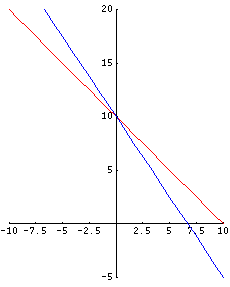

تاريخ الرياضيات

الاعداد و نظريتها

تاريخ التحليل

تار يخ الجبر

الهندسة و التبلوجي


الرياضيات في الحضارات المختلفة

العربية

اليونانية

البابلية

الصينية

المايا

المصرية

الهندية


الرياضيات المتقطعة

المنطق

اسس الرياضيات

فلسفة الرياضيات

مواضيع عامة في المنطق


الجبر

الجبر الخطي

الجبر المجرد

الجبر البولياني

مواضيع عامة في الجبر

الضبابية

نظرية المجموعات

نظرية الزمر

نظرية الحلقات والحقول

نظرية الاعداد

نظرية الفئات

حساب المتجهات

المتتاليات-المتسلسلات

المصفوفات و نظريتها

المثلثات


الهندسة

الهندسة المستوية

الهندسة غير المستوية

مواضيع عامة في الهندسة

التفاضل و التكامل


المعادلات التفاضلية و التكاملية

معادلات تفاضلية

معادلات تكاملية

مواضيع عامة في المعادلات


التحليل

التحليل العددي

التحليل العقدي

التحليل الدالي

مواضيع عامة في التحليل

التحليل الحقيقي

التبلوجيا

نظرية الالعاب

الاحتمالات و الاحصاء

نظرية التحكم

بحوث العمليات

نظرية الكم

الشفرات

الرياضيات التطبيقية

نظريات ومبرهنات


علماء الرياضيات

500AD

500-1499

1000to1499

1500to1599

1600to1649

1650to1699

1700to1749

1750to1779

1780to1799

1800to1819

1820to1829

1830to1839

1840to1849

1850to1859

1860to1864

1865to1869

1870to1874

1875to1879

1880to1884

1885to1889

1890to1894

1895to1899

1900to1904

1905to1909

1910to1914

1915to1919

1920to1924

1925to1929

1930to1939

1940to the present

علماء الرياضيات

الرياضيات في العلوم الاخرى

بحوث و اطاريح جامعية

هل تعلم

طرائق التدريس

الرياضيات العامة

نظرية البيان
Systems of Linear Equations
المؤلف:
المرجع الالكتروني للمعلوماتيه
المصدر:
www.almerja.com
الجزء والصفحة:
...
9-3-2017
2115
Systems of linear equations take place when there is more than one related math expression. For example, in y = 3x + 7, there is only one line with all the points on that line representing the solution set for the above equation.
When you face 2 equations in the SAME QUESTION, there will be two lines on the same xy-plane. The following two equations are graphed on the same xy-plane:
y = 3x + 5
y = - x
The solution set to any equation is the place where BOTH equations meet on the xy-plane. This meeting place is called the Point of Intersection. If you have a linear equation and a quadratic equation on the same xy-plane, there may be TWO POINTS where the graph of each equation will meet or intersect.
Here's a geometric view:

Here is a sample of two equations with two unknown variables.
Sample:
Solve
x + y = 10
3x + 2y = 20
There are three methods to solve our sample question:
1) We can solve it graphically
2) We can solve it algebraically
3) We can also solve it through algebraic elimination
I will solve the question using all 3 methods.
Method 1: Solve Graphically
To solve graphically, it is best to write BOTH equations in the slope-intercept form or in the form: y = mx + b where m = the slope and b = the y-intercept as your first step.
So, x + y = 10 becomes y = - x + 10 (slope-intercept form)
NEXT: 3x + 2y = 20 becomes y = -3x/2 + 10 (slope-intercept form)
Step 2: Plug different values for x to find points in the (x,y) form leading to the point of intersection.
After doing the algebra, I found that BOTH equations meet at point (0,10) . Point (0,10) means that if you plug x = 0 and y = 10 into BOTH original equations, you will find a balance of the equations. In other words, you will get the SAME ANSWER on BOTH sides of each original equation.
Here's what these two equations look like on the xy-plane:

Method 2: Solve algebraically
Steps:
1) Solve for eaither x or y in the first equation (x + y = 10).
I will solve for y. So, x + y = 10 becomes y = -x + 10, which really means
" y in terms of x."
2) Plug the value of y (that is, -x + 10) in the second equation to find x.
Our second equation is: 3x + 2y = 20.
3x + 2(-x + 10 ) = 20
Next: Solve for x
3x -2x + 20 = 20
x + 20 = 20
x = 0.
3) Plug x = 0 into EITHER original equations to find the value of y.
I will use our second equation.
3x + 2y = 20
3(0) + 2y = 20
0 + 2y = 20
2y = 20
y = 10.
So, our point of intersection is once again (0,10).
Method 3: Algebraic Elimination
This method deals with matching the variables to ELIMINATE or do away with.
Keep in mind that it is your choice which variable you want to eliminate first.
GOAL: Eliminate x and solve for y or vice-versa. Let's go back to our original equations.
In our second 3x + 2y = 20, you can eliminate 3x by multiplying -3 by EVERY term in our first equation (x + y = 10).
x + y = 10
3x + 2y = 20
-3(x) + -3(y) = -3(10)
3x + 2y = 20
-3x + -3y = -30
3x + 2y = 20
NOTICE that -3x and 3x are eliminated. See it? See why? Here's why: A negative PLUS a positive = ZERO.
We now have this:
-3y = -30
2y = 20
-3y + 2y = -30 + 20
-y = -10
y = 10.
Next: To find x, we plug y = 10 into EITHER of the original equations. By now you should see that our answer for x will be ZERO.
Here it is:
I will use x + y = 10
x + 10 = 10
x = 0.
 الاكثر قراءة في مواضيع عامة في الجبر
الاكثر قراءة في مواضيع عامة في الجبر
 اخر الاخبار
اخر الاخبار
اخبار العتبة العباسية المقدسة

الآخبار الصحية















 "المهمة".. إصدار قصصي يوثّق القصص الفائزة في مسابقة فتوى الدفاع المقدسة للقصة القصيرة
"المهمة".. إصدار قصصي يوثّق القصص الفائزة في مسابقة فتوى الدفاع المقدسة للقصة القصيرة (نوافذ).. إصدار أدبي يوثق القصص الفائزة في مسابقة الإمام العسكري (عليه السلام)
(نوافذ).. إصدار أدبي يوثق القصص الفائزة في مسابقة الإمام العسكري (عليه السلام) قسم الشؤون الفكرية يصدر مجموعة قصصية بعنوان (قلوب بلا مأوى)
قسم الشؤون الفكرية يصدر مجموعة قصصية بعنوان (قلوب بلا مأوى)


















